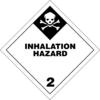Segregation Chart for Load, Transport, Storage
In this table a statement is contained for each hazard class whether the loading, transport or storage with other hazard classes is allowed, is not permitted or is restricted. The table is based on U.S.-Code 49 CFR §177.848.
Note: In this segregation and separation chart are HazMat of hazard class 2.3 considered depending on their poisonousness by inhalation (Hazard zone A/B). See
PHMSA Interpretation #09-0252.
There are no restrictions with hazardous materials, as pointed out in the instructions for using the Segregation Table (see
49 CFR §177.848(e)). But please, refer to following requirements in
49 CFR §177 Subpart B (Loading and Unloading):
- §177.834 - General requirements
- §177.835 - Class 1 materials
- §177.837 - Class 3 materials
- §177.838 - Class 4 (flammable solid) materials, Class 5 (oxidizing) materials, and Division 4.2 (pyroforic liquid) materials.
- §177.839 - Class 8 (corrosive) materials
- §177.840 - Class 2 (gases) materials
- §177.841 - Division 6.1 and Division 2.3 materials
- §177.842 - Class 7 (radioactive) material
- §177.843 - Contamination of vehicles.



